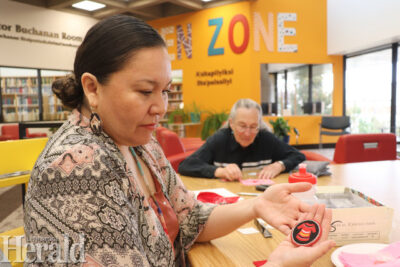Library hosting Red Dress Day
By Lethbridge Herald on May 4, 2022.
 Herald photo by Nicholas Allen
Library Technician and Indigenous Services worker Marilyn Contois holds up a beaded pin for Red Dress Day at the Lethbridge Public Library.
Herald photo by Nicholas Allen
Library Technician and Indigenous Services worker Marilyn Contois holds up a beaded pin for Red Dress Day at the Lethbridge Public Library.Nicholas Allen – for the LETHBRIDGE HERALD
A beading class at the Lethbridge Public Library on Wednesday focused on red dress pins in memory and honour of missing and murdered Indigenous women for Red Dress Day.
Red Dress Day takes place annually on May 5 and is a day that brings awareness and calls for all Canadians to speak out on violence against Indigenous women, girls and Two-Spirit people.
Library Technician and Indigenous Services worker at the Lethbridge Public Library, Marilyn Contois, lead the beading class at the main branch as part of preparations for today’s Red Dress Day.
“That’s where it’s been designated as the day to commemorate, remember and honour the missing and murdered Indigenous people and bring awareness to that,” said Contois. “And like with last night’s documentary we watched a National Film Board documentary called Finding Dawn.”
Finding Dawn was developed by Métis filmmaker Christine Welsh that puts a human face to the epidemic of missing or murdered Indigenous women in Canada. The film takes a journey into the experiences of Indigenous women from Vancouver, down the Highway of Tears in northern BC, and on to Saskatoon, where the murders and disappearances remain unsolved.
“And it happens everywhere. It even happens here. Sometimes it doesn’t make it to the news or the press,” said Contois.
She explained that even though some people may resurface, they’re not making connections with their family.
“Make sure people know where you are. Have a plan, look out for one another,” added Contois. “Do the best that we can to prevent these things from happening within our own communities and being kind to everybody.”
That compassion is a quality that beading class participant Debbie Kelman, the artist who made Her Hands: A Tribute to Anna Mae Pictou Aquash, said her painting tried to convey. The need for people to be calm and kind to each other.
“My grandmother always taught us that nobody is above us or below us. We’re all equals no matter what your situation is in life, and to remember that,” said Kelman.
Kelman’s painting was a concept that originated from the idea of creating an Indigenous angel. She was taking a native art class and had to do a large painting.
“The ideas just kind of came together,” explained Kelman who drew inspiration from the history of the Jingle dress and its relationship with healing. “I knew I wanted to [paint] an angel. I had a friend who was Hungarian and one time we were looking at some angels and she said, ‘How come angels are always blonde?’ So that made me think, yeah, why are angels always blonde,” said Kelman.
She described her painting as both horror and healing. The painting focused on multiple aspects of Anna Mae Pictou Aquash’s past, but the removal of her hands by the FBI for identification was an aspect of the case that stuck with her.
“That’s why I wanted to do [the handprints], was the horror of how this could have happened,” said Kelman, “Thinking of my own hands and my role as a woman, mother and artist. Everything that we do is with our hands.”
On the back of the painting there’s two handprints that stand for Indigenous ancestors according to Kelman.
“When you get a name in the Blackfoot way, someone will stand behind you and put their hands on your back and kind of push you,” she said. “I drew from that inspiration as well, too, so it’s the ancestors supporting us and encouraging us, pushing us.”
When Kelman did the painting, the Red Dress Day movement was not yet formed, so she found it interesting to see how it has evolved and that the painting now has even more personal meaning.
“It was really special for me when I did that painting, it was really a spiritual experience. I felt the ancestors with me,” said Kelman. “[Anna Mae] wasn’t the first missing and murdered Indigenous woman, and sadly, she’s not going to be the last one.”
Another guest at the beading class, Chief Beginning of a New Day Hosanna waa ksis to akii (Brave Woman), explained the purpose of sharing these messages while not calling them stories. In her Sioux culture, they would call it a truth speaking because a story can be fiction. She said when they are talking about the death of loved ones or missing loved ones, it is not telling a story. What Indigenous people are doing is sharing lived experiences.
“In residential school we were always screamed at, ‘Oh, you’re just telling a story’, and so we automatically assume stories are make believe or they’re not true…whereas in our real life we’re living and we’re sharing our lived experiences through our truth speaking,” Chief Beginning of a New Day explained. “We’re not telling stories anymore. We’re sharing our truth speaking with you, and that makes it so much more serious.”
There will be a Red Dress Day presentation online today between 11:30 a.m. and 12:30 p.m. and a Kainai elder will join to be present for an honour song and a prayer according to Contois.
“We have some dancers that are coming to us from a local Indigenous organization. They’ve graciously volunteered their time to come and do a healing dance to remember and honour the families that are now grieving the loss of loved ones,” said Contois.
The Lethbridge Public Library invites anybody who wants to hang a red dress, artwork or anything that signifies missing and murdered Indigenous women, girls and Two-Spirit people to share what they have.
To attend the event or see the painting, visit the Lethbridge Public Library in person or go online to lethlib.ca to find out more.
26-25




